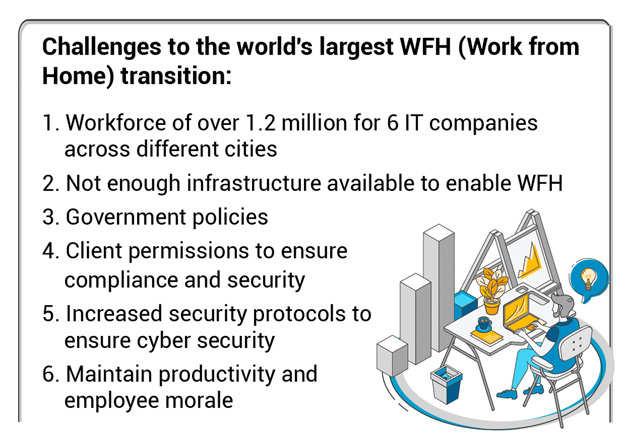News: IT campuses will never be the same: How India’s 4 million IT workers shifted to working from home overnight-24-04-2020
Updated on : 24-04-2020
IT companies had to move desktops that employees were using at their workplaces to their homes as they could not procure laptops in multiple thousands at such short notice. Alongside, there was the critical aspect of ensuring compliance and security. Despite all this, all of India's IT majors successfully executed this humongous shift.

PUNE/MUMBAI: Ramkumar Ramamoorthy had never seen this coming.
For the nearly three decades that he has been with Cognizant, Ramamoorthy, the chairman for the IT firm’s India operations, has planned for hundreds of scenarios that could disrupt business. For each of these, the company’s global crisis management team has a plan and in some cases it has successfully ensured business continuity in disasters such as during the Chennai and Kerala floods.
With over two of the three lakh odd employees of Cognizant based out of India delivering services to its customers globally, it was only natural for such plans so that clients don’t get hurt.
However, the March 24 lockdown upended all such contingency plans of the company and for India’s $147-billion outsourcing industry.
“Nobody could have created a playbook for what we are witnessing today,” says Ramkumar Ramamoorthy, Chairman and Managing Director, Cognizant India.
In the absence of a playbook or precedent to rely on, the company set up a core committee that works across multiple work streams to ensure delivery and service continuity, while safeguarding employee health and wellbeing.
The lockdown meant almost 90% of its two lakh employees could not work from its campuses spread across India and as it spread globally, from its offices in Europe and the US.
Cognizant, while US headquartered, has adopted the offshore driven model of Indian outsourcers such as Tata Consultancy Services, WiproNSE -1.74 % and InfosysNSE -3.14 %, with seven out of ten employees working out of India.
Ramamoorthy said that one of the biggest challenges in making this transition was logistics and infrastructure.
Indian IT companies had to move desktops that employees were using at their workplaces to their homes as they could not procure laptops in multiple thousands at such short notice. Alongside, there was the critical aspect of ensuring compliance and security.
“We worked with customers to get permissions for work for home with appropriate security protocols,” says Ramamoorthy.

The world’ largest transition to work from home
It was not just Cognizant. Larger rival Tata Consultancy Services and India’s largest IT employer also made the shift, as also other software firms such as Infosys, HCL Technologies, Wipro and Tech Mahindra. These companies combined employ over 1.2 million people and contribute almost half of India’s software exports.
TCS says that it had built a infrastructrure model that could shift its nearly 4.5 lakh employees to work remotely. The pace of the shift post the Covid-19 lockdwon was challenging as it had relook project management methodologies and also ensure adequate security that satisfies client needs.
“The outcome was our Secure Borderless Workspaces framework, which has now enabled close to 90% of our employees to work remotely and securely,” said N Ganapathy Subramaniam, chief operating office at TCS. “ Despite the lockdowns, our customers continue to experience the same energy and delivery certainty from TCS as before”. It shifted over 40,000 desktops to employees so that they can work from home.
Infosys provided high speed broadband connectivity for remote workers and expanded by ten times its own virtual private network bandwidth. It also shipped 35,000 computers to employee residences and made sure that there was four times increase in backend capacity to support the increase in concurrently connected remote users.
“The impact caused by COVID-19 since last few weeks of March has led to significant displacement in the operating model while severely testing business continuity plans of companies,” said U B Pravin Rao, chief operating officer at Infosys.
Similarly, Tata Communications set up a task force to assess, monitor and respond to the crisis early on, making working from home mandatory wherever possible globally, even before many countries announced lockdown measures.
“Collaboration with remote colleagues was already the norm in our business. As a global company with a highly distributed workforce, we’ve had flexible working policies in place for some time now,” says Amur S Lakshminarayanan, MD & CEO, Tata Communications.
At Wipro, A global crisis management task force chaired by the COO was activated, and by 15th March, 1,65,000 client facing employees in India were working from home.
“We proactively reached out to our customers, briefed them of the measures we were adopting and sought their approval. All these hectic efforts ensured that today, ~93% of our employees are approved to WFH by our customers and ~90% of our employees engaged in projects have been enabled globally to WFH,” says CEO Abidali Neemuchwala.
Government help
Transitioning such a large number of employees comes with its own share of practical challenges, from logistics to securing the required permissions from clients and managing employee morale. Industry body Nasscom swung into action as well, lobbying with the Department of Telecom to waive certain requirements to enable work from home for IT employees. To be sure, the government acted swiftly, with several ministries collaborating and allowing delivery of services remotely.
Global tech major IBM has had a culture of collaborating with colleagues digitally for many years now, and the process and rigour to do so efficiently is already built into the system making the employee transition fairly seamless. The bigger challenge for the company was around how they work with their enterprise clients like retailers or banks.
“A lot of our developers work inside the bank in their facilities. Sometimes, the clients haven’t thought of the same degree of flexibility in business continuity, so we proactively help and support our clients to switch to that way of working,” says Prashant Pradhan, VP & CTO, Asia Pacific, IBM Global Markets. The key is to ensure that the IBM staffer can continue to work securely even when he’s not on their premises, which could involve helping with hardware or software requirements, while ensuring compliance at the same time.
Lakshminarayanan said that Tata Communications had seen a surge in demand to help clients with their own business continuity plans and to enable them to work from home. And the clients don’t seem to be complaining.
“Since activating our business continuity plan, we have seen a sharp rise in our customer sentiment score which is being monitored regularly to ensure service levels and quality are maintained,” he said.
Leadership and communication are the other key issues companies have had to focus on. Pradhan said that with leaders also working remotely, it becomes important how they continue to lead large teams of people and ensure that they are comfortable and manage the situation with their respective clients. Several companies have initiated virtual tea or coffee breaks where people can gather for an informal chat online.
Cognizant has ramped up the number of activities on its employee portal and put in place several employee assistance programs. Most companies have upped the amount of communication that goes out to the employees, CEO downwards.
“This is the time to over communicate,” says Ramamoorthy.
The new normal of remote working
Most industry watchers believe that this will have a long term impact on how the IT industry functions. TCS has already drafted a plan that looks at only a quarter of its employees working from offices by 2025, with the remaining delivering services remotely. Wipro is already looking at leveraging its TopCoder platform where services can be delivered remotely from anywhere and it can be done even by gig workers.
Sridhar Mitta, founder, NextWealth Entrepreneurs says that this experience will prove that people can operate out of any location.
“Over the next few months, companies will realise what can be done from home and clients too will gain comfort in this way of working,” says the former Wipro CTO. In time, this could mean more people would work remotely, even once the situation normalises.



